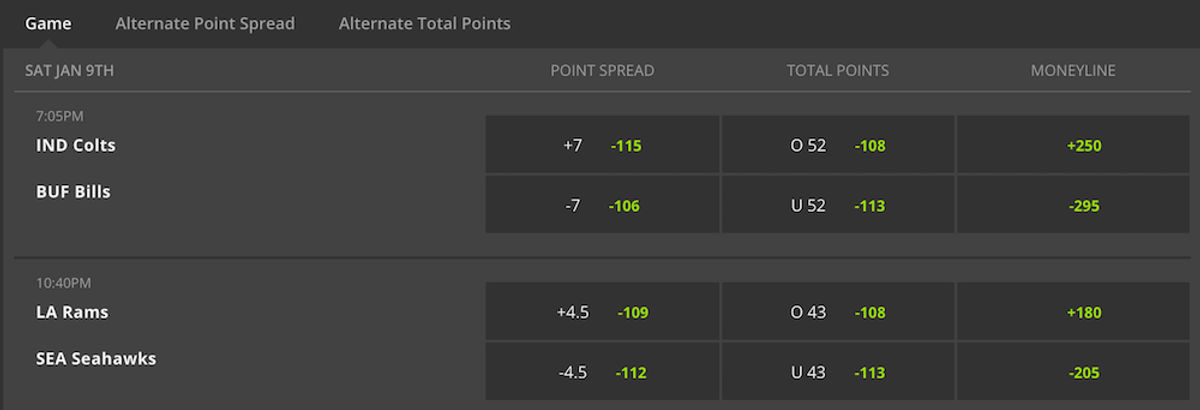A point spread, or betting line, is the means by which a sportsbook attempts to evenly match two teams of unequal skill levels.
The point spread can be understood as how many points the favored team would have to “give” to the underdog team for the game to be viewed as equal. The line is often accompanied by odds which dictate the monetary level of the bet as well as the payout.

The Point Spread is one of the three core markets in the sports betting world. It practically evens the field in all matches regardless of the sport. In addition, operators use point spreads to extend the betting options for punters.
You will always have clear favorites in almost every round in all popular leagues and competitions across different sports. So there is no point in backing a massive choice priced at -5000 or -10000 to win.
Sportsbooks increase the range of betting possibilities by adding an extra edge for the underdogs. They add a certain number of points to the team expected to lose the tie creating the situation where both outfits have an equal chance to win.
This market is mainly used for football and basketball bets, but it applies to all sports.
Basketball Points Spread Example: Huge underdogs (priced at -5000) in an NBA match (say Los Angeles Lakers with Lebron James and Anthony Davis take on New York Knicks) are boosted by around 20 points by Sportsbooks to allow bettors to predict whether they will lose by a margin higher than 20 points.
Bettors get a much better price for backing favorites to win by 20 points (around even odds) than they’d get by simply supporting them to win the contest.
There are just two possible winning scenarios in points spread. You get a certain line and back whether the favorites will beat their counterparts by a margin higher than that set by the line. The favorites are listed as minus (-) in the point spread, while you will recognize the underdogs by the plus (+) sign. If you are backing the underdog, your bet is a winner if the team wins the game, draws, or loses by a margin fewer than the one set by the line.
There are certain instances when you get your money back (a push) if the line is set at 5.0 or 6.0 or 7.0 etc. If you back a certain team to win by a margin higher than 5.0 and they win by exactly five points difference, your money will be refunded. Most sportsbooks use lines such as 4.5, 5.5, 6.5, etc. to leave just two potential options and avoid the refund thing.
This market can be applied to all sports. It comes in quite handy for tennis where you’d normally have nothing to bet on when Roger Federer, Novak Djokovic, or Rafael Nadal take on the rest of the field. This trio has dominated the sport in the last two decades and they are usually -1000, -5000, or -10000 favorites to win their matches against any rival.
However, points spread allows you to still enjoy watching them play and have a genuine bet where you back the difference in the number of games won by them or the opponents. You can thus go with Federer to beat Tsonga by a margin higher than four games (in the entire match) at much more attractive -110 odds. The same goes for football, basketball, hockey, tennis, soccer, and all other sports.
Example on Point Spread Betting Wager
Here is an example to show the use of point spread betting in a basketball match. You can apply it to all other sports.
Miami Heat @ Los Angeles Lakers
| Sportsbook | Spread Line | LA Lakers to win | Miami to win |
| Draftkings | -8.5 | -110 | -110 |
| PointsBet | -8.0 | -110 | -110 |
| FanDuel | -7.5 | -130 | 100 |
Los Angeles Lakers are -400 favorites to beat the Miami Heat in front of the home crowd at Staples Center. Nobody is going to get rich backing the home win at such high odds while it is hard to believe the visitors can make a huge upset even though their win is paid at whopping +300 odds.
In this case, two sportsbooks give you an option to back whether Los Angeles Lakers will win by a margin higher than 8 points (DraftKings and PointsBet), while FanDuel has set the line at 7 points. As you can see, the odds are pretty much identical across all bookies (not only those listed in the table).
Now, if you back Los Angeles -8.5, your bet is winning as long as the Lakers win by 9 points or more. In all other cases, the bet will let you down. If you go for Miami +8.5, you will win the bet if the Heat wins, force the game into overtime (draws), or lose by a margin fewer than 8 points. If the line is set at 8.0 (like in the PointsBet example), the sportsbook will return your stake if the Lakers win by exactly 8 points difference.
The Point Spread market is easily visible with all online sports betting operators. Here are the three markets you will see highlighted for all matches in football, basketball, baseball, hockey and tennis across every single sports bookmaker:
- Spread Betting (Handicap)
- Over/Under (Total Points)
- Moneyline (Match Winner)

DraftKings Point Spread, Total Points and Moneyline
To make a bet, you just have to click on the odds for your desired pick (say Lakers to win by at least nine points difference) and the match will pop up in the bet-slip on the right side of the main page (or an app if you are using a portable device). You should then just choose the stake and place the bet.
DraftKings Sportsbook - Best for point spreads
All sportsbooks in the US will have offers for point spread bets for almost every single betting market. The best sportsbook for point spread betting according to us is DraftKings. Read our DraftKings review to get an understanding of why this is one of the best sportsbooks for you.
- One of the Largest Gambling Sites in the US
- Offers Casino, Sportsbook & DFS
- Great Promotions
Bet $5, Get $150 in Bonus Bets Instantly
The main goal for sportsbooks is to have equal money on both sides of a point spread. They calculate the fine line based on statistics and leave you to choose one of two potential scenarios, usually given at the same price. It will generally be the -110 price, meaning you have to stake $110 to get a $100 profit.
This is a common type of pricing, which includes the house edge. Without their advantage, you’d have +100 odds on either side. Nevertheless, the -110 odds on both sides is industry-standard pricing.




